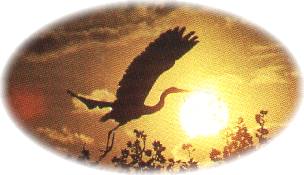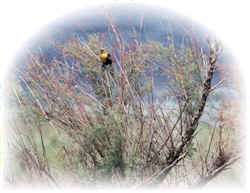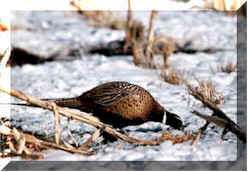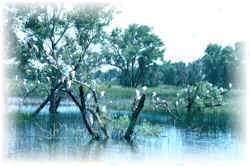
For untold years, the ancient Big and Little Salt Marshes have attracted thousands of migrating waterfowl, providing them with food, cover, and a place to rest during exhausting flights between breeding and wintering areas. Indians and early settlers hunted the waterfowl in these marshes, and shortly after the turn of the century, commercial hunting provided wagonloads of waterfowl to Kansas City restaurants and other eastern points.
With the decline of commercial hunting came the establishment of hunting clubs whose acquisition of private lands helped preserve valuable waterfowl habitat from further development. Moreover, these clubs worked to improve the habitat -- among their attempts is the channel permitting Rattlesnake Creek to flow directly into Little Salt Marsh. Additional canals were dug later, proving the entire area with a more dependable water supply.
Today these marshlands remain a major stopover for thousands of migrating birds.
Quivira National Wildlife Refuge is 22,135 acres of prairie grasses, salt marshes, sand dunes, canals, dikes, and timber. Quivira is named for a tribe of Indians who were visited by Coronado in 1541.
A system of 21 miles of canals and 25 miles of dikes provides nearly 6000 acres of managed wetlands and marshes. Little Salt Marsh and Big Salt Marsh are ancient basins that have seen hundreds of thousands of water-fowl arriving for food, cover, and a place to rest on migration trips. During spring migration QNWR becomes a staging area for 500,000 birds.
Mammals prosper here and enjoy protection, food and a quiet lifestyle. Reptiles and amphibians abound along with resident bird species and those passing through to complete cycles of life. Quivira is a quiet, almost-never-see-a-human experience enjoyed by naturalists, photographers and wildlife lovers.
HIKING TRAIL - Original prairie, stabilized sand dunes and 15 acres of century-old cottonwoods encourage log speculative walks. An easy walk is Migrant's Mile Nature Trail which is wheelchair accessible.
BIRD/WILDLIFE WATCHING - Bird watching and wildlife viewing opportunities abound at Quivira NWR. What you see  depends largely on the time of year as well as the time of day you are here. For optimum viewing, early morning or late afternoon are suggested. Bobcats, coyotes, and other mammals are often seen lurking about during the heat of the afternoon. At the extreme north end of the Refuge, a thriving prairie dog community can be found.
depends largely on the time of year as well as the time of day you are here. For optimum viewing, early morning or late afternoon are suggested. Bobcats, coyotes, and other mammals are often seen lurking about during the heat of the afternoon. At the extreme north end of the Refuge, a thriving prairie dog community can be found.
Quivira NWR has two large salt marshes, one located at the south end of the Refuge and the other at the far north end on the Wildlife drive. Both are excellent places to look for birds such as mallards, wood ducks, pintails, white pelicans and more. Fall is an excellent time to see large numbers of these birds. If you are more interested in shorebirds and water birds, the spring and early summer are the best times to visit. It is not uncommon to see large numbers of Great blue herons, American avocets, sandpipers, and snowy plovers, as well as the beautiful white-faced ibis, or the spinning phalaropes going round and round in circles stirring up the mud looking for a meal.
As you travel through the Refuge, keep your eyes open for white-tailed deer, beaver, raccoons, wild turkeys and other wildlife. There are many parking areas throughout the Refuge which afford visitors a chance to stop and walk around the Refuge or take photographs. No matter what time of year you choose to come, a sharp-eyed visitor will certainly see something worth remembering.
HUNTING & FISHING - Autumn and winter are great times of the year for the hunters among you to come on out and test  your hunting skills. Hunting for waterfowl, quail, pheasant, dove, snipe, rails, squirrels, and rabbits is permitted on Quivira NWR. It is always a good idea to call ahead at 316-486-2393 or stop by the Visitors Center or one of the many information kiosks located around the Refuge to get a copy of the most recent Refuge hunting regulations which may differ from general state regulations. An example of this would be that non-toxic shot is required in all gauges when hunting any game on the Refuge. Parts of the Refuge are posted as "Public Hunting Area" and hunting outside of these areas is prohibited. Retrieving game from areas closed to hunting is prohibited. The use of dogs for hunting and retrieving is encouraged. You must be in compliance with the State of Kansas hunting laws and regulations, otherwise no specific permits or fees are required by the Refuge, and check in at Refuge Headquarters is not necessary. Check out the "Current Bird Information" section during hunting season for the current bird numbers and the "Looking Out the Window Weather Report" (updated Daily!) or e-mail us at r6rw_qvr@fws.gov. For information on State Hunting and Fishing regulations, please contact the Kansas Department of Wildlife and Parks at 316-672-5911.
your hunting skills. Hunting for waterfowl, quail, pheasant, dove, snipe, rails, squirrels, and rabbits is permitted on Quivira NWR. It is always a good idea to call ahead at 316-486-2393 or stop by the Visitors Center or one of the many information kiosks located around the Refuge to get a copy of the most recent Refuge hunting regulations which may differ from general state regulations. An example of this would be that non-toxic shot is required in all gauges when hunting any game on the Refuge. Parts of the Refuge are posted as "Public Hunting Area" and hunting outside of these areas is prohibited. Retrieving game from areas closed to hunting is prohibited. The use of dogs for hunting and retrieving is encouraged. You must be in compliance with the State of Kansas hunting laws and regulations, otherwise no specific permits or fees are required by the Refuge, and check in at Refuge Headquarters is not necessary. Check out the "Current Bird Information" section during hunting season for the current bird numbers and the "Looking Out the Window Weather Report" (updated Daily!) or e-mail us at r6rw_qvr@fws.gov. For information on State Hunting and Fishing regulations, please contact the Kansas Department of Wildlife and Parks at 316-672-5911.
Hunting Information and Seasons:
Hunting licenses may now be purchased on-line from the Kansas Department of Wildlife and Parks (KDWP) website. All you need are a credit card and a printer. For information on how to get your license, go to the KDWP website at www.kdwp.state.ks.us. Quivira is closed to deer hunting at all times, however, if you wish to hunt deer and you don't know where to go, KDWP now has a referral service. You can reach them at 1-888-497-8661 to get information on local landowners who may allow deer hunting on their property. All other questions about hunting and fishing should be directed to 316-672-5911.
Dove Hunting Opens on Quivira
The first hunting season of the fall starts on Quivira National Wildlife Refuge on September 1st, with the opening of dove hunting. The 8000 acres of public hunting land on Quivira is open to hunting under Kansas State Regulations, hours and limits. Dove hunters are reminded that, as with all hunting on Quivira NWR, only non-toxic shot may be used. Possession of lead shot, while in the field, is a violation of Refuge regulations and hunters should be careful not to make the mistake of having lead shot shells in their hunting vest.
Fishing at Quivira 
Fishing is allowed on all bodies of water on the Refuge. In addition, we now have a "Kids Fishing Pond"...adults MUST be accompanied by a fishing child, 14 years of age or younger. This pond, located near the south entrance of the Refuge, is periodically stocked and affords the younger fisherfolks out there a chance to experience the thrill of landing a big one! Again, you must be in compliance with State fishing regulations and laws. Sorry, no boats are allowed.
The U.S. Fish and Wildlife Service seeks to afford persons with disabilities full accessibility or reasonable accommodation. We have made every effort to provide accessible activities for everyone including an accessible hunting blind, viewing scope, photo blind and fishing pier. The accessibility hunting blind needs to be reserved at least two weeks in advance so make your plans early. Contact Refuge personnel at 316-486-2393 for information or to address accessibility problems. For the hearing impaired, use your State Relay System for the Deaf. You may also e-mail us at r6rw_qvr@fws.gov.
